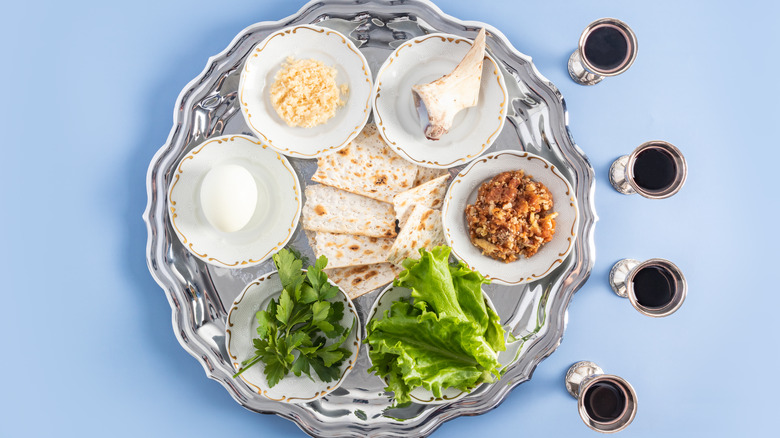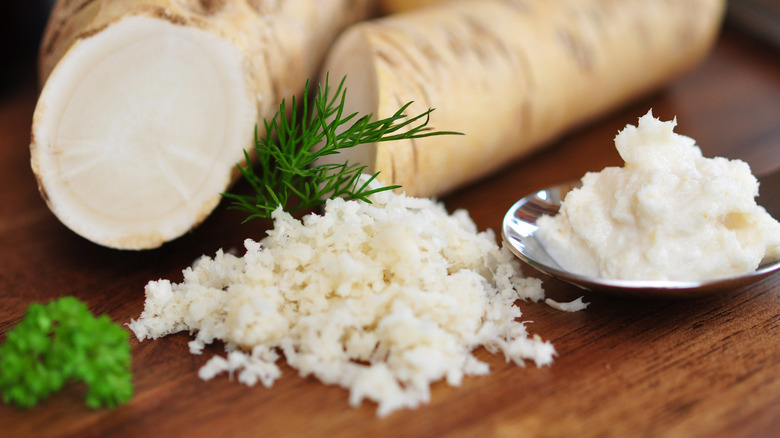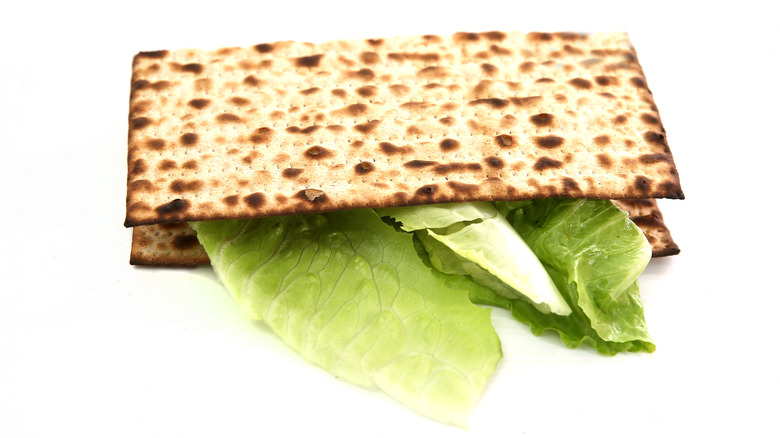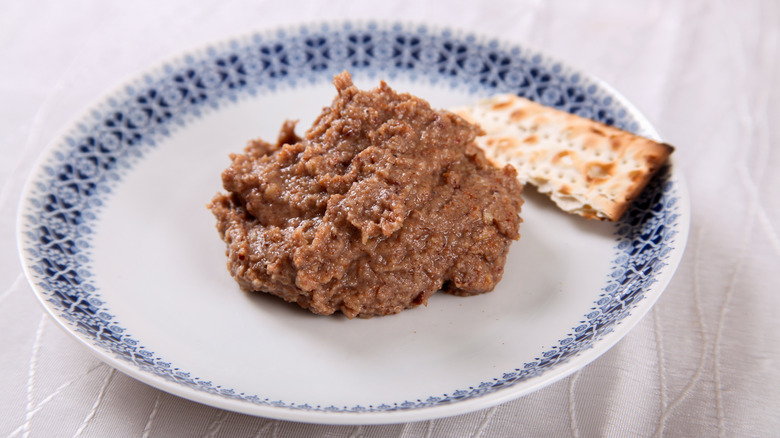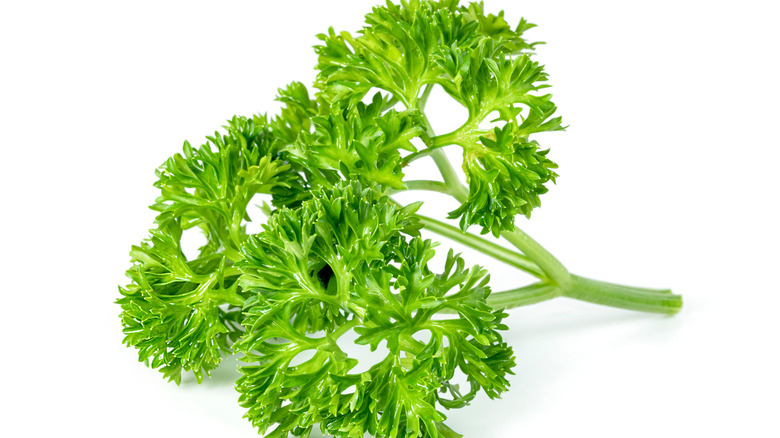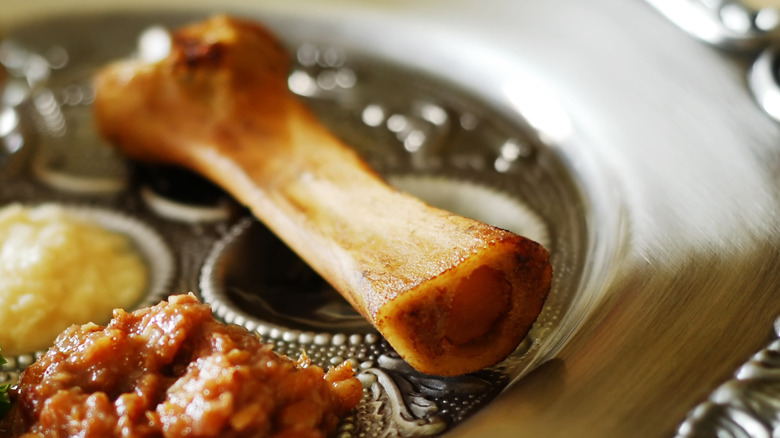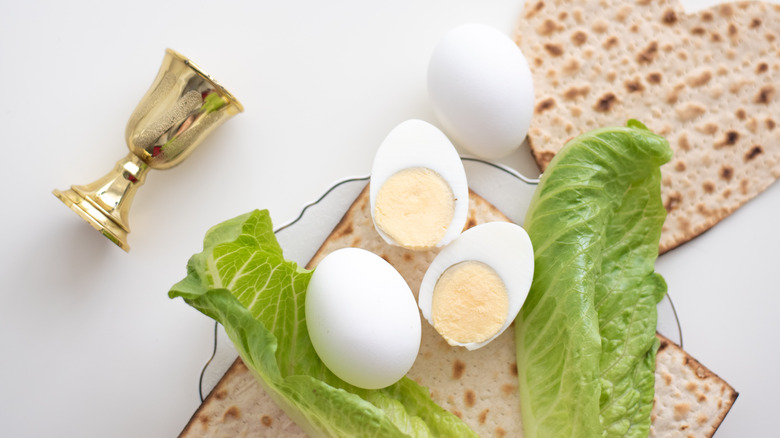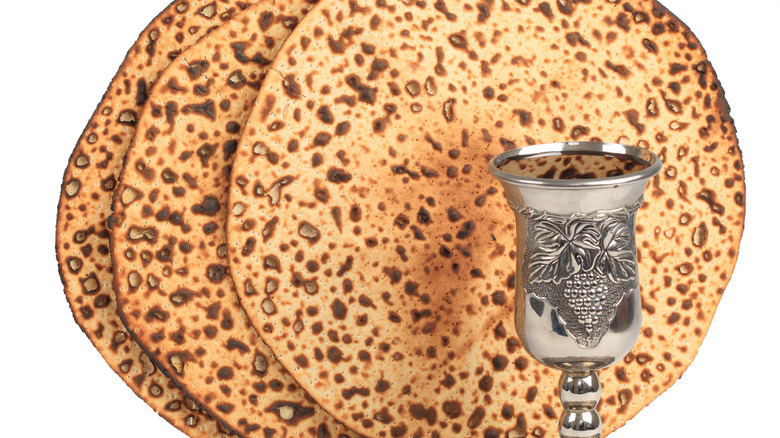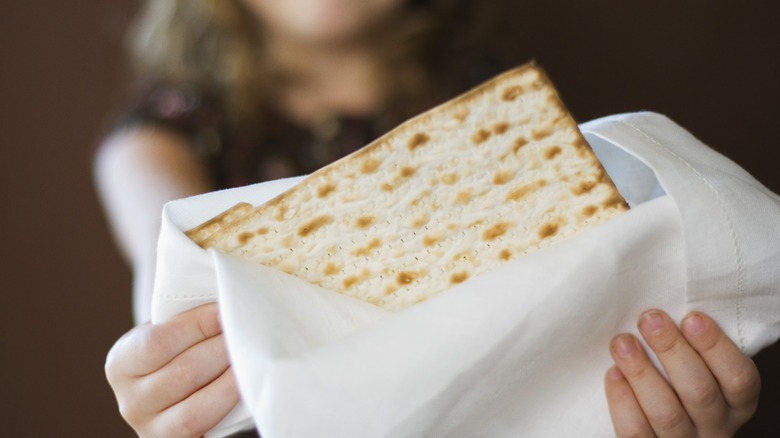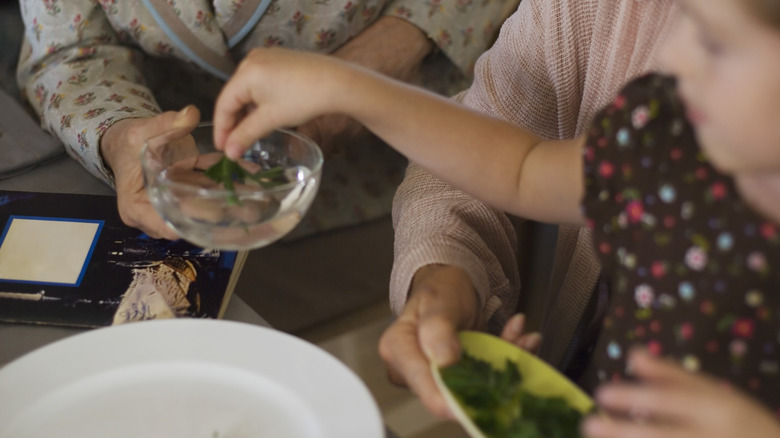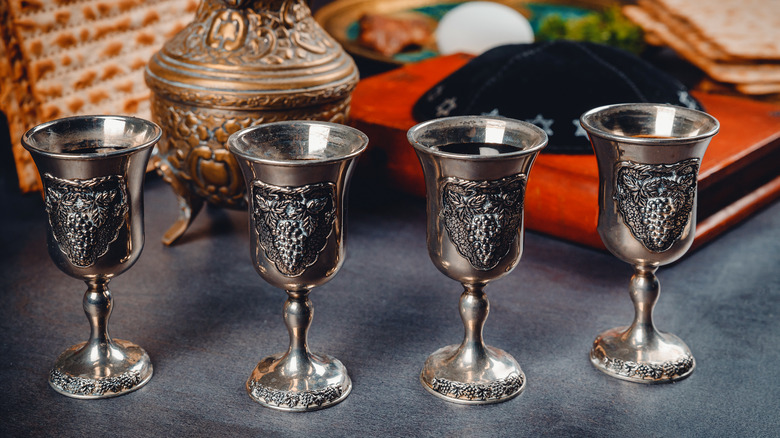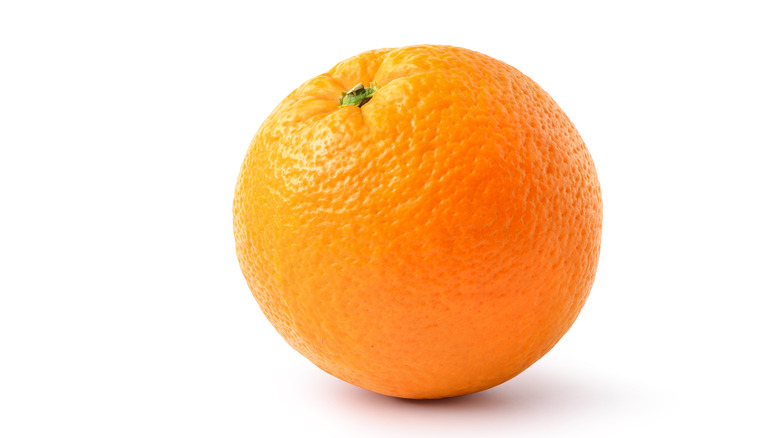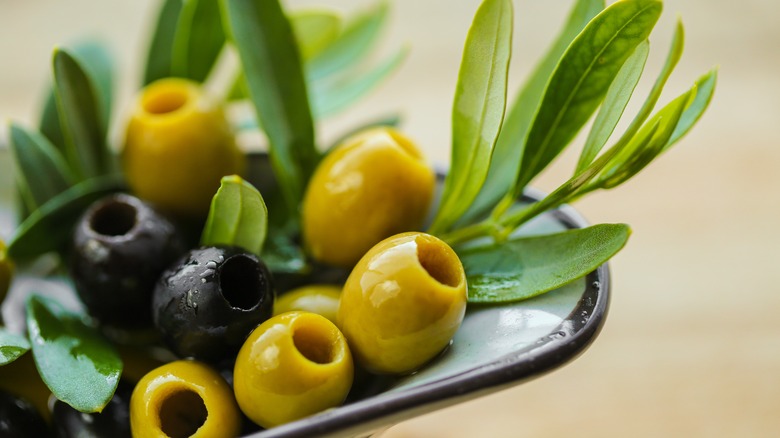12 Foods That Make Up A Traditional Seder Meal (& What Each Symbolizes)
Passover is a springtime holiday in Judaism that celebrates the story of the Israelites' escape from slavery in Egypt, as told in the Torah. It is generally celebrated for seven or eight days, depending on where you live. On the first (and sometimes also the second) night, it is traditional to have a celebratory meal called a Seder. During the Seder, a number of rituals are performed in a prescribed order as ordained by the Haggadah, a text that is read aloud during the meal. Although the list of rituals is always basically the same, there is no single standard Haggadah, and it varies regionally and even from family to family. The text is a retelling of Moses leading the Jews from Egypt, but it is often edited and given extra commentary depending on the religious or political persuasions of the people who are celebrating.
Generally, the Passover meal is split into two parts. The Seder comes first, and then it's followed by Passover dinner, which is a typical festive meal that usually features traditional Jewish foods. Today, we're focusing on the Seder foods, each of which has a deeply symbolic and metaphorical meaning. We'll list all of the major components of the Seder plate and explain their history and what they mean in the context of the celebration.
Maror
Maror is one of two types of bitter herbs eaten at the Passover table. As with some of the other Seder foods, its significance comes from the text of the Passover story in the Torah. In Exodus 12:8, God tells Moses that every Hebrew family in Egypt needs to sacrifice a lamb, saying, "They shall eat the flesh that same night; they shall eat it roasted over the fire, with unleavened bread and with bitter herbs." Each household is commanded to mark its doors with the lamb's blood. That night, God kills the firstborn son in every house in Egypt except the Jewish ones, which are protected by the markings on the doors. God "passing over" Jewish families is the basis for the Passover holiday.
Maror is Hebrew for bitter herb. The Torah does not explain why bitter herbs are a necessary part of the sacrifice, but the common explanation is that it acts as a reminder of the bitter lives lived by the Israelites in Egypt. Similarly, the text doesn't specify what the maror should consist of. In practice, many foods are eaten as maror, and only some are what you would commonly consider to be herbs (though they're always at least a little bitter).
One of the common maror options is horseradish, either the prepared jarred stuff or fresh, but bitter greens like lettuce, endive, and celery are also popular, depending on the interpretation. It's typically dipped in fruit-based charoset before being eaten.
Chazeret
Chazeret is a second pile of bitter herbs on the Seder plate, though not everybody includes it in their meal. Some families simply have one pile of maror. You can use the same general types of vegetables for chazeret as maror. In fact, some people just use one vegetable (generally horseradish or lettuce) for both. However, it's quite common to use horseradish for maror and lettuce for chazeret.
The primary distinction between chazeret and maror is how it is eaten and placed in the Passover ritual. The chazeret is eaten after the maror as part of the korech, also known as the Hillel sandwich. This dish is named after the famous ancient Rabbi Hillel the Elder, who believed that you should eat the lamb, bitter herbs, and matzo components of a Passover dinner together as a sandwich. Today, the korech typically consists of bitter herbs (and sometimes charoset, but more on that in a bit) sandwiched between two pieces of matzo.
Charoset
The word "charoset" is derived from the Hebrew word for "clay." The most popular explanation for its significance as a Sedar element is that charoset is meant to recall the mortar that enslaved Israelites had to use when forced to work on construction projects in ancient Egypt. However, some argue that it's actually a kind of ritual disinfectant that was supposed to kill pathogens in the maror. Either way, charoset is likely a descendant of ancient Roman fruit-based condiments that were typically eaten with salad greens.
Its role in a traditional Seder is as a topping or dip for the bitter herbs. Charoset is always made from fruit, wine, spices, sweeteners, and nuts, but the specific ingredients and consistency (from chunky to paste-like) vary depending on local food practices.
The type of charoset you're most likely to find at Seders in the U.S. is based on Ashkenazi Jewish traditions. Ashkenazim came from Eastern Europe, and their charoset recipes are usually fruit salad-like mixtures with lots of apples. Our easy charoset recipe is typical of this style. Sephardic Jews, who are based in the Middle East and the Mediterranean, use local ingredients from those regions like cardamom, dates, and honey. You can even find historical recipes that use actual clay as an ingredient, although this is rare.
Karpas
Karpas is the springtime vegetable eaten at the Seder table. In contrast with the maror and chazeret, which have somewhat somber meanings, the karpas is a symbol of optimism. It represents the renewal of springtime and the agricultural bounty of the season. On a deeper level, it's a symbol of how the Hebrews flourished before being pressed into slavery in Egypt.
Although karpas is often some type of leafy green, it doesn't have to be — the main requirement is that it can't be anything picked from a tree or a vine. Jews from Eastern Europe often use potatoes. Confusingly, there is some overlap between the vegetables used for karpas and maror. Some families will use celery as karpas, while it can be maror for other people. Even more confoundingly, the most popular karpas in the U.S. is something that more closely fits the common definition of an herb than any of the traditional Passover "bitter herbs": parsley.
Other than being a vegetable, the other requirement for karpas is that it be dipped into some kind of liquid. In the vast majority of households, it's dipped into saltwater, but in ancient times it was sometimes dipped into charoset. Depending on the regional and family traditions, other dips like vinegar or even hummus may be used.
Zeroa
The zeroa is one of two cooked dishes on the traditional Seder plate. Both dishes represent sacrificial offerings, but the zeroa is supposed to symbolize the Passover sacrifice that was done when the Temple still stood in Jerusalem (and where now only the Western Wall remains). The zeroa generally consists of some type of roasted animal bone, most commonly a lamb shank. Unlike the other traditional Seder foods, you are not supposed to eat the bone. Although it is meant to recall a sacrificial meal, in order to avoid the food seeming too much like the outlawed practice, it is not eaten but simply placed on the plate instead, according to Chabad.org.
In addition to its significance as a remembrance of past sacrifices, the zeroa has a secondary meaning. There's a reason it's often a long, thin bone like a lamb shank: The shank symbolizes God's arm as mentioned in Deuteronomy 26:8: "And the Lord brought us out from Egypt with a strong hand and with an outstretched arm, with great awe, and with signs and wonders."
Beitzah
The beitzah, which is typically a roasted (though sometimes just hard-boiled) egg, is the other nod to ancient sacrifices present on a Passover table. It commemorates the Chagigah, which was an offering given both on Passover and on other holy days while the Temple of Jerusalem still stood. The beitzah has a twofold meaning. On the one hand, it's a solemn symbol of mortality and mourning. The round shape of an egg connects it to the concept of the circle of life, and eggs are an inducement to mourn the destruction of the Temple by the Romans. However, the circle of life encompasses rebirth as well as death, and eggs can be seen as a hopeful metaphor for spring, much like karpas.
Beitzah is customarily eaten towards the end of the Seder. Like karpas, it's dipped in saltwater. After the beitzah and at the end of the Seder, which consists of (not very substantial) ceremonial foods, you can fill up on the actual dinner portion of a Passover meal.
Three matzot
In additional to the traditional Seder plate, matzo is also an essential part of the meal. This unleavened bread helps recall the story of Exodus because the Jews did not have time to let their bread rise as they were hurriedly escaping Egypt. As it says in Exodus 12:39, "And they baked matzo cakes of the dough that they had taken out of Egypt, for it was not leavened, since they had been driven out of Egypt and could not delay." While North Americans are probably familiar with the hard, cracker-like matzo sold in boxes around this time of year, it's not the only type. This crunchy matzo is made in the Ashkenazi style. In the Middle East, matzo comes in form of soft, floppy wraps.
Another Ashkenazi-specific matzo tradition is that the Passover Seder is accompanied by three loaves of matzo. This is in contrast to Shabbat dinners and other holiday meals, which are traditionally served with two loaves of bread. It also runs counter to the Talmud, which suggests serving Passover dinner with one whole matzo and one broken one. The broken piece is an acknowledgment that matzo is the bread of the poor, who often can't afford whole loaves. The origins of the third piece of matzo come from the writings of medieval Ashkenazi rabbis. It's meant to be saved as leftovers that can be given to the less fortunate.
Afikoman
The afikoman is many children's favorite part of the Passover tradition. It can even be a way to make sure small children stay awake through the Seder, with its long recitation of the Haggadah. One of the matzot at Passover is traditionally broken in half at the beginning of the Seder. One half is left on the table while the other is hidden somewhere in the house. The broken matzo, in addition to its significance in paying respect to the poor, the broken matzo may also be another reference to the Temple of Jerusalem's sacrifices.
The hidden portion of the matzo is the afikoman, and at the conclusion of the Seder (before dinner proper starts), the children are set free to hunt for it. Once it's found, everyone takes a bite. Sometimes the kid who finds the matzo receives a present. The specific practices surrounding the afikoman are highly regional and dependent on the traditions of each family. In some Middle Eastern countries, the afikoman is seen as a talisman that can ward off bad luck, so it's saved all year until the next Passover.
Saltwater
As we mentioned, the karpas is usually dipped in saltwater. This is the first thing that's eaten during the Seder. The spring vegetable is also meant to represent Joseph's coat of many colors, which is connected to the story of how the Jews first came to Egypt.
This is the origin of one of the symbolic explanations for the saltwater: It is a representation of the blood that Joseph's jealous brothers dipped his coat into after they sold him into slavery. You dip the karpas in saltwater just as Joseph's brothers dipped his coat in blood. This is also why some traditions have you dip the karpas in vinegar instead; red wine vinegar is a stronger visual analog for blood.
The saltwater is also said to symbolize the suffering the Jews went through in Egypt and tastes like the salty tears they cried before they were able to escape bondage.
Wine
Although it's not strictly food, wine plays a crucial role in a traditional Passover Seder. Unlike the bitter herbs and matzot, there's no explicit scriptural justification for drinking wine at Passover; though, references to drinking wine in a celebratory way are scattered throughout the Torah. As with most other aspects of the Seder, the wine is consumed in a specific ritual way: You drink four cups throughout the Seder, leaving a fifth cup untouched in order to hopefully entice the prophet Elijah to visit.
There are many different explanations for why tradition calls for four cups of wine at the Seder. One of the most popular is that it commemorates the four different words God uses for saving the Jews from bondage in Egypt. Another popular story is that each cup of wine symbolizes one of the crimes committed against the Israelites by the Egyptian Pharaoh in the Torah. It could also be that the wine represents the four Jewish exiles throughout history.
The importance of wine in the Seder ritual can be a challenge for people who are dealing with alcoholism. Fortunately, in the last couple of decades, it has become common to organize sober Seders where the wine is replaced with grape juice.
If you or anyone you know needs help with addiction issues, help is available. Visit the Substance Abuse and Mental Health Services Administration website or contact SAMHSA's National Helpline at 1-800-662-HELP (4357).
Orange
While most of the Seder traditions we have discussed so far are ancient (or, at least, have roots in ancient symbolism), the orange that finds its way onto some families' Seder plates is a much more recent innovation. Dr. Susannah Heschel is credited with originating the Seder orange in the 1980s. It symbolizes the rights of LGTBQIA+, women, and other marginalized groups within the Jewish community. She chose an orange specifically because she believes that Jewish people will be more fruitful overall when these diverse voices are fully accepted, according to the Jewish United Fund. A commonly-repeated origin for the orange is that a male heckler stood up during one of Dr. Heschel's lectures and a woman is as out of place on the pulpit as an orange would be on a Seder plate.
As compelling as that story is, Heschel has debunked it. Instead, the Jewish United Fund says the professor was inspired by a progressive Haggadah written by Oberlin students that features a conservative Rabbi angrily saying that there's no place for lesbians within Judaism. In that Haggadah, a piece of (leavened) bread, not an orange, is used as the example of something that doesn't belong at a Seder. However, Heschel decided to use an orange since bread isn't Kosher for Passover.
Olive
The olive is an even more recent Passover tradition than the orange. Like the orange, it's not a universal part of the Seder spread and it has a political meaning. It gained popularity in 2008 when the advocacy group Jewish Voice for Peace began promoting the idea as part of a wider effort by the organization to donate olive trees to Palestinian farmers. The Trees of Reconciliation Project, as it was called, fit into the group's mission to fight what it sees as Palestinian oppression by the modern state of Israel.
More broadly, olives have been seen as a symbol of peace since ancient times. A dove returning with an olive leaf signaled to Noah that the turmoil of the Great Flood was finally over. The Greek myth about the founding of Athens also involves an olive tree and the ancient Greeks associated olives with prosperity and other virtues. Families who are passionate about pursuing peace in the Israeli-Palestinian conflict may include an olive on their Seder plate to commemorate this whether or not they are supporting Jewish Voice for Peace's specific initiatives.
